Are you interested in becoming a DJ but don’t know where to start? You can DJ without a controller or any other equipment but your laptop! Laptop DJing is a great option for those who want to try mixing music on their computer without any expensive equipment. All you need is a laptop and an internet connection to get started.
In this guide, we will show you how to use your laptop to DJ, whether you are a beginner or an experienced DJ looking to upgrade your gear. We will cover everything from setting up your laptop for DJing to learning how to mix music and create professional-sounding sets.
So if you love music and want to try your hand at DJing, this guide is for you!
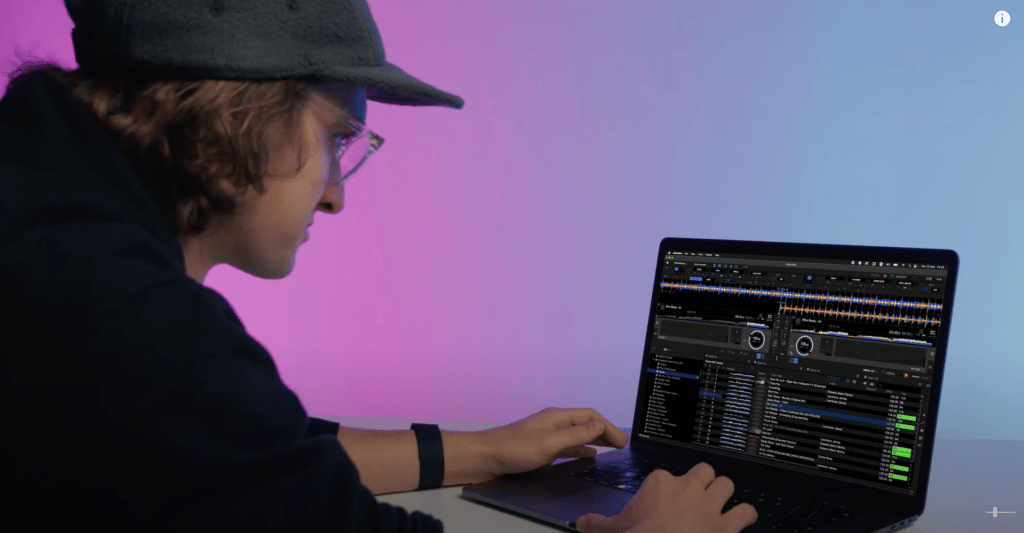
In this tutorial, you will learn the basic skills needed to DJ and put tracks together seamlessly. You don’t need to spend any money on DJ hardware to get started. Just follow along and practice mixing your favorite songs. If you’re not sure what music to use, Crossfader has a free music pack available for download to use with this and other beginner DJ tutorials.
We will guide you through all the essentials a DJ needs to organize their music, prepare a playlist, and start mixing. Additionally, we will cover some fundamental music theory and explore options for further DJ lessons, including access to another free tutorial on more advanced techniques for DJing with a laptop.
Article Guide
- Video Tutorial
- Why Rekordbox
- Free DJ Music
- Music Organisation
- Rekordbox Modes
- Essential Rekordbox Settings
- Importing Music & Missing Files
- Making Playlists
- Mixer & Deck Controls
- What Is Beatmatching?
- Beats, Bars & Phrases
- Mixing In Phrase
- Your First Mix
- Next Lesson
What is Crossfader?
Before we get you up and running, here is a little about us:
At Crossfader, we are dedicated to helping you succeed in the music industry.
Our founder, Jamie Hartley, is an experienced DJ and instructor who has spent years sharing his knowledge and expertise with others. He has worked with many well-known DJs, and now he and our skilled team are here to support you in achieving your goals, whether it’s improving your skills or promoting your brand to get more gigs.
Let us help you take your career to the next level!
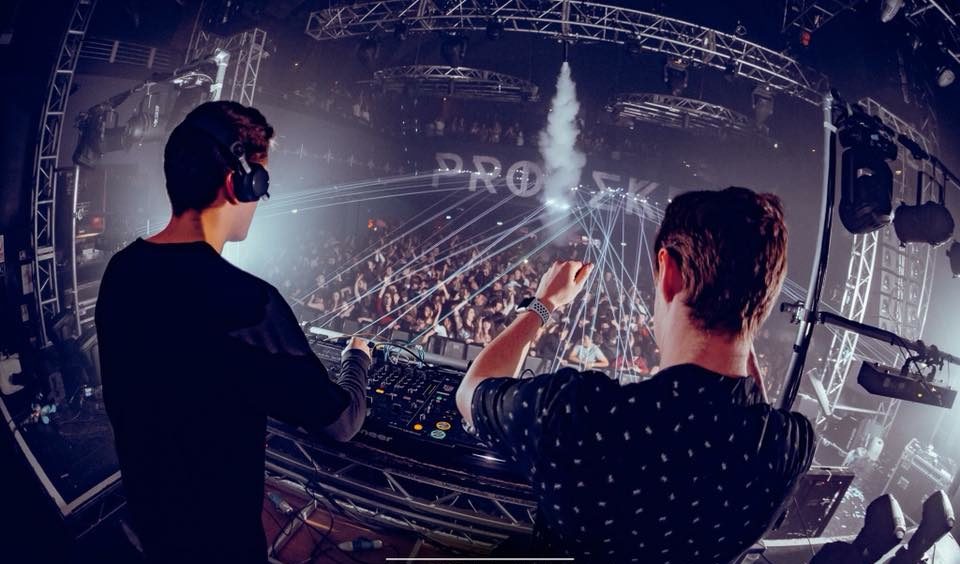
Let’s go…
Before you start mixing, there are some technical details you should be aware of. Don’t worry, these are important to understand and will not only help you get started with your first mix, but also improve your skills as a DJ overall.
To make it easy, we have created a step-by-step guide and a video featuring Jamie, who will walk you through everything you need to know. In addition, we have highlighted the key settings and concepts you should familiarize yourself with. With these resources, you’ll be mixing with no controller or any other DJ gear and sounding like a pro in no time!
When you’re ready to start DJing, the first thing you’ll need to do is decide which platform to use. There are many options available, and they all have everything a beginner needs to get started.
For the purpose of this tutorial, we recommend Rekordbox because it offers the most benefits for those new to DJing.
Why Rekordbox?
Pioneer DJ’s performance platform, Rekordbox, is perfect for beginners who want to learn DJing with powerful yet easy-to-use features. As you progress, you can upgrade to one of their popular controllers, such as the DDJ-FLX4, DDJ-FLX6, or DDJ-1000, and take your skills to the professional level. Trust us, Rekordbox is a great choice for any aspiring DJ.
The reasons Rekordbox is a great choice for this tutorial:
- It’s FREE
- Fully featured
- Prepares users for club standard gear such as the CDJ-3000 and DJM-A9.
- Allows recording for listening back to practice sessions
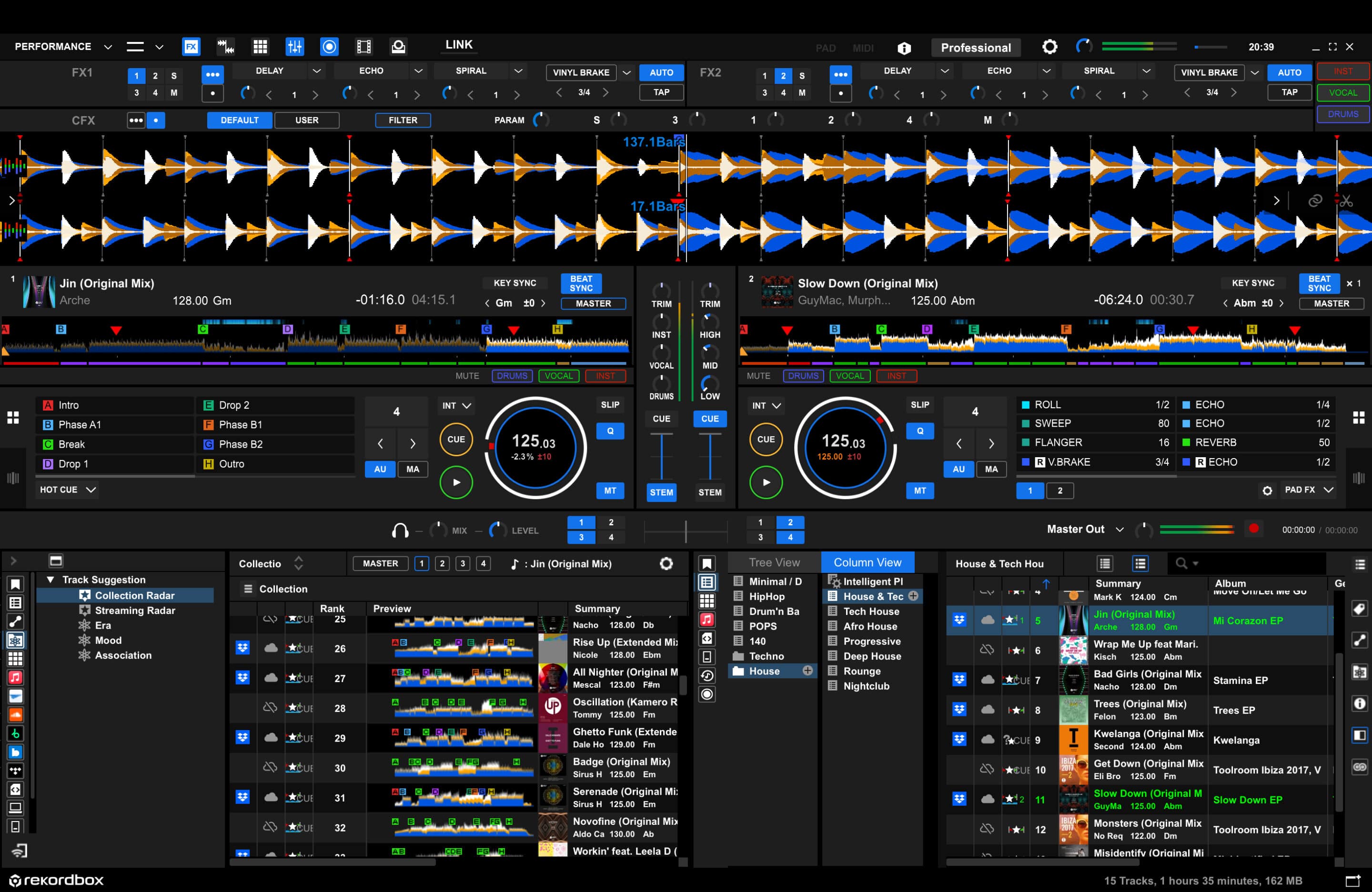
A screenshot of Rekordbox’s interface in Performance Mode
It’s also made by Pioneer DJ, a leading manufacturer of professional DJ equipment, so you’ll get a feel for working with top-of-the-line gear from the beginning. Plus, the Rekordbox product line has something for DJs at every skill level, from beginner controllers to advanced all-in-ones to professional media players. And, the best part is that everything you learn and save in Rekordbox can be easily transferred to a Pioneer DJ club setup.
Free DJ Music
To start DJing, you’ll need some music to play. We’ve created a free multi-genre music pack that you can download and use to follow along with this lesson.
Simply sign up for our email list to get access to this resource, plus an additional free tutorial that builds on the video above.
Find this useful? We’re only scratching the surface!
Become a lifetime Crossfader member and we’ll give you subscription-free access to all the tools, tips, tutorials and ongoing support you need to make a real success of DJing at a pro level!
Check out our Complete DJ Package for a money-back guaranteed way to up your game right away!
Make sure you organise your music!
Good organization is key when it comes to using Rekordbox. There are many ways to get music into the software, but how you arrange the files on your computer can affect whether Rekordbox can access them.
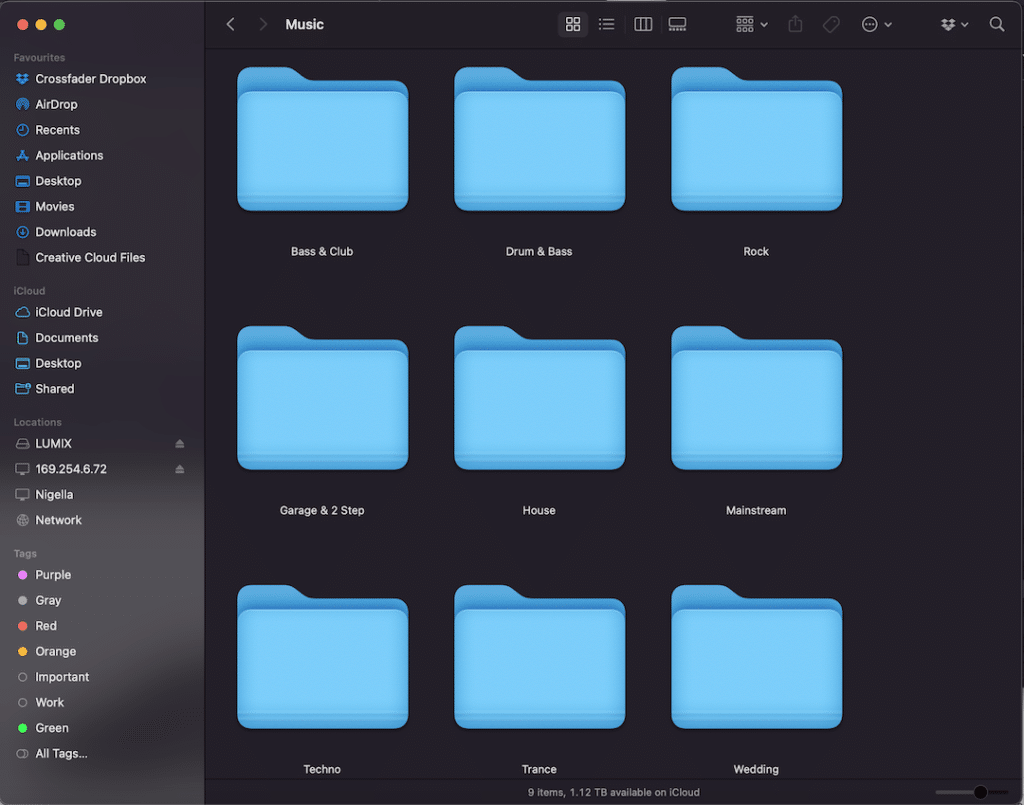
Organise your music on your computer before importing to Rekordbox
If you frequently move the music around, it may not load and you won’t be able to play it. That’s because Rekordbox doesn’t actually host the music, it just saves the location of the files on your computer so it can access them as needed. Keep this in mind as you save your music to your computer to avoid any issues.
Rekordbox Install
To install Rekordbox, you’ll need a modern laptop that meets the technical requirements listed on their website. Simply click the link to get the installation pack, then press ‘Download’ from the top menu. Follow the prompts to install the software, agree to the terms and conditions, and create a Rekordbox account (you don’t need to sign up for a plan at this time). With these steps, you’ll be up and running in no time.
Export vs Performance Mode
Once you’ve installed and opened Rekordbox, you’ll notice that it has two main modes: Performance and Export.
Export mode is used to prepare music files with performance data (information that helps with mixing) and transfer them to a USB stick or SD card to be played on CDJs or XDJs, which is what most professional DJs do in clubs.
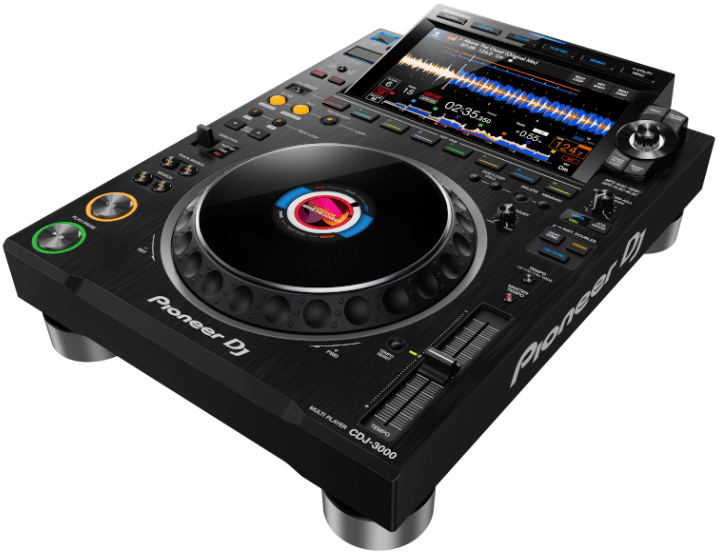
Pioneer DJ CDJ-3000
To DJ on a laptop, we’ll be using Performance mode. To switch between modes, use the drop-down list at the top left corner of the screen in Rekordbox.
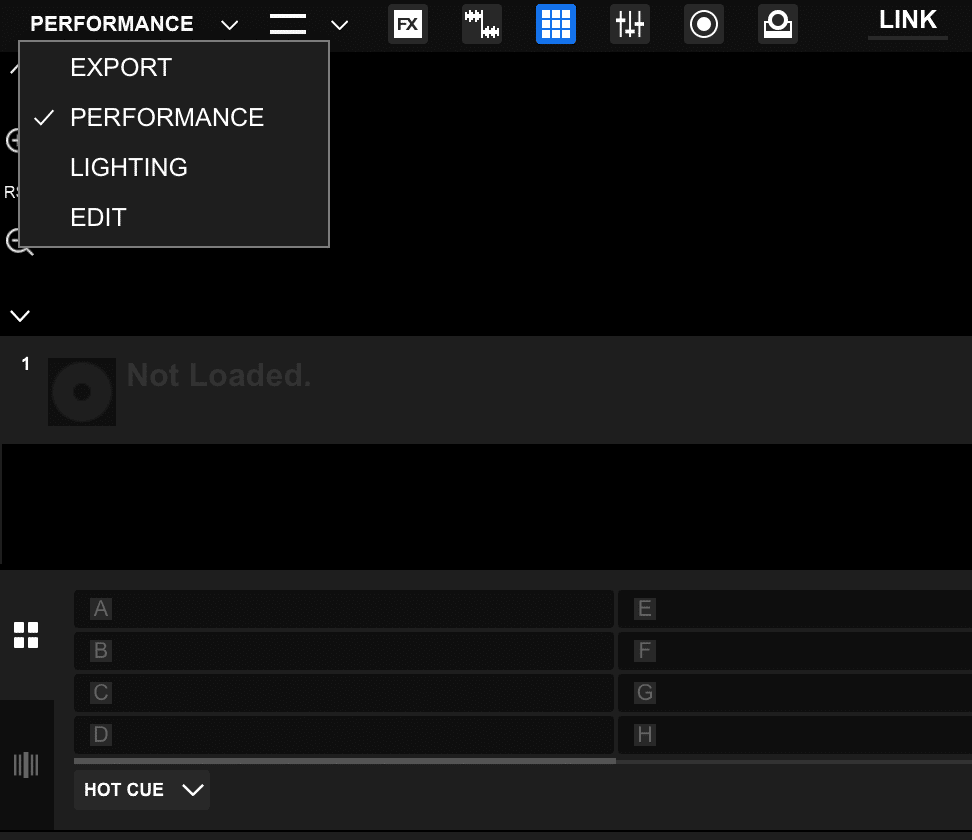
Rekordbox Performance Mode
Collection and Tree View
In Performance Mode, you’ll see two decks on the main screen, with a tree view of your music collections on the left and an open collection in the centre. To load a track onto a deck, simply drag and drop it from the open music collection.
Essential Settings
Before you start playing music, it’s a good idea to make sure that the settings in Rekordbox match your preferences. This will help you get the same results as in the tutorial when you follow along. To access the preferences, click the gear icon in the top right corner of the navigation bar in Rekordbox.
Starting with View, scroll down to Layout, and within this find Tree View and make sure the following options are checked:
- Related Tracks
- iTunes
- SoundCloud
- Beatport
- Beatsource
- TIDAL
- Explorer
- Playlist Palette
- Display Cue Markers on Preview
- OSC Sampler
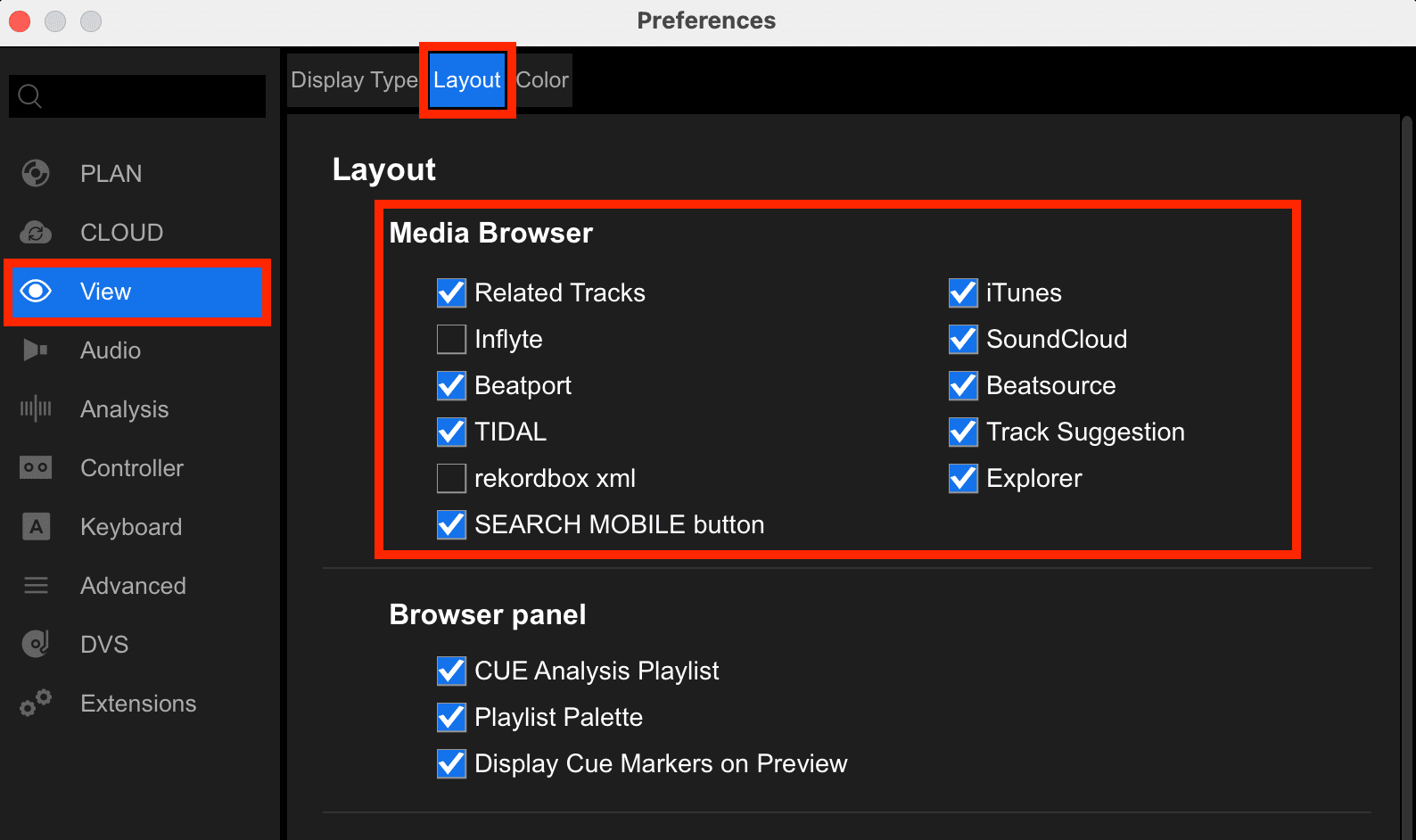
Rekordbox Tree View Layout Settings
Effect Panel
- BEAT FX + SOUND COLOR FX
This ensures you will be able see all of the effects that we use in our lessons.

Enlarged Waveform
- Auto
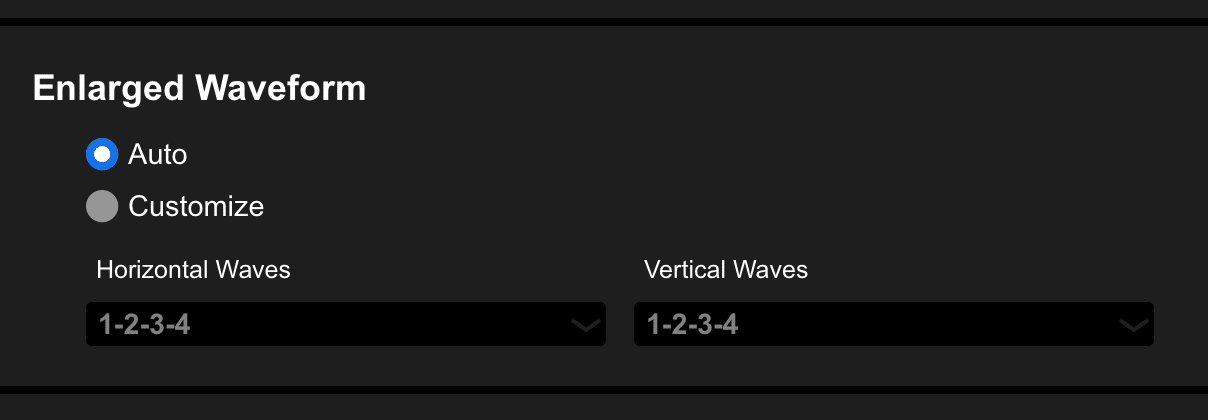
PAD Mode
- Customize
And then, from the drop-down list, select PAD Display

Tooltips
- Show Tooltips
This feature is great for beginners as it explains what every function within Rekordbox does if the cursor hovers over it!

Waveform Drawing Rate
- High Speed
Color
- 3Band

So your waveforms don’t look any different to ours when following along.
Full/Preview Waveform
- Half Waveform
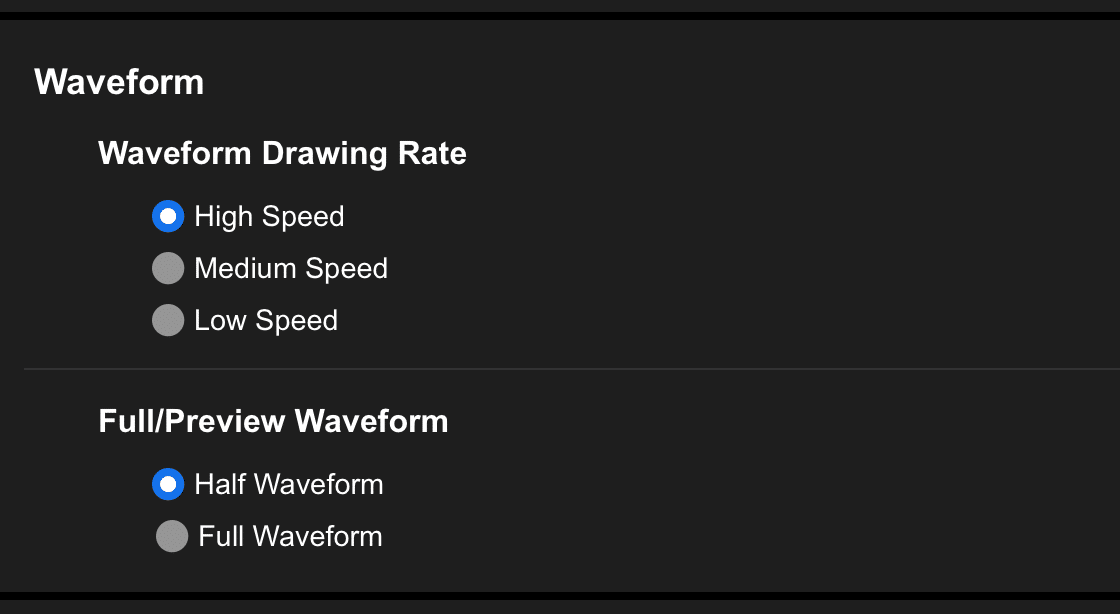
Beat Count Display
- Current Position (Bars)

Switch JOG Display
- Current CUE / SLIP

Key display format
- Alphanumeric
Traffic Light
- Related Key 2

Skin
- Dark
HOT CUE
- Colorful
Pad FX
- Set the different effects to your own colour preference
Sampler
- Fixed
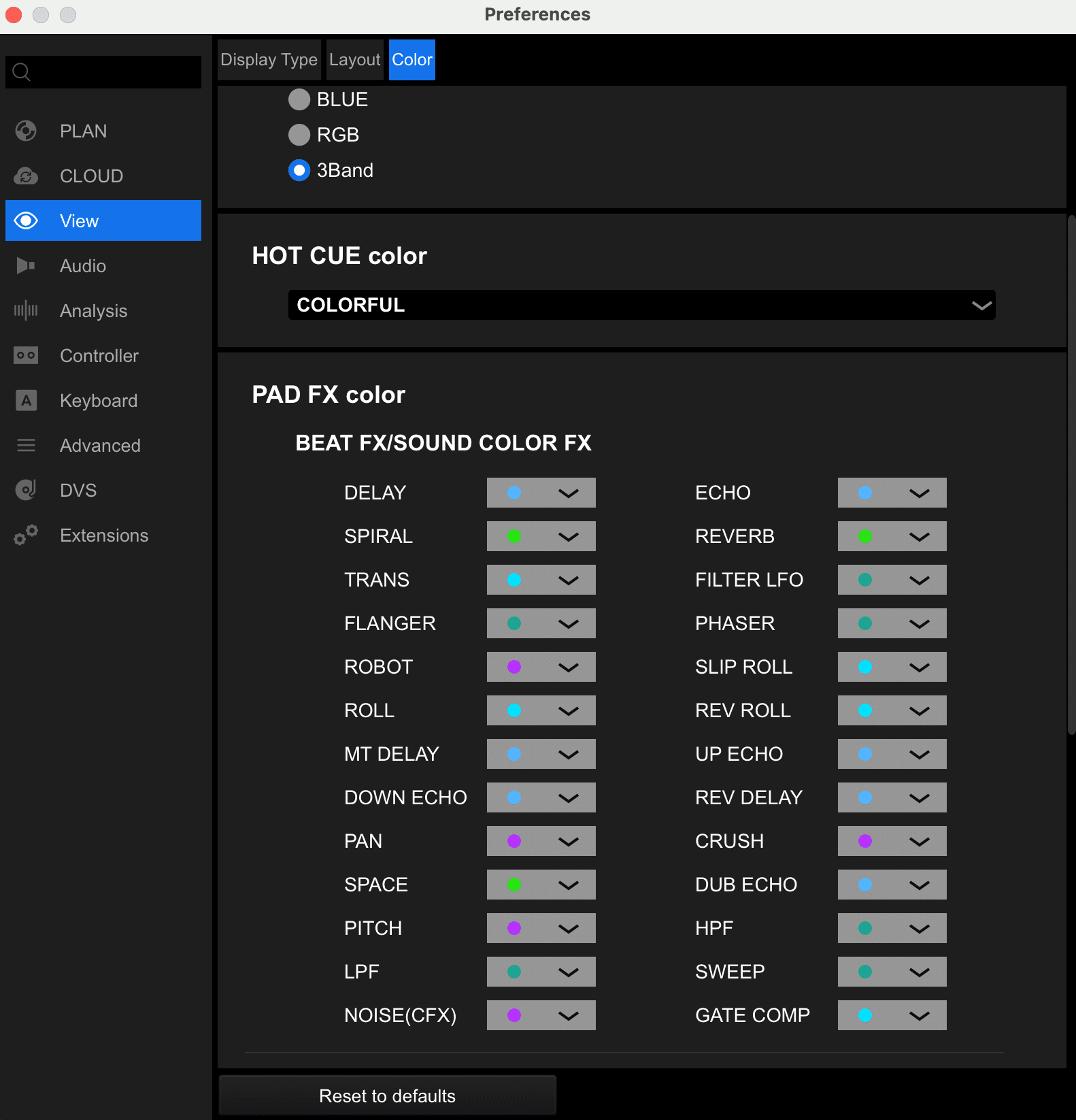
Music Analysis
In order to optimize our music for mixing in Rekordbox, we need to set the analysis preferences. This includes calculating the Beats Per Minute (BPM) and setting the beat grid for each track.
BPM and beat grid data are essential for mixing tracks smoothly and applying effects accurately. To set the analysis preferences, go to the “Analysis” tab and under “Track Analysis Mode,” select “Normal.” This option is best for music with a consistent tempo pattern, as it is more efficient than “Dynamic” mode, which is used for music with fluctuating tempos.
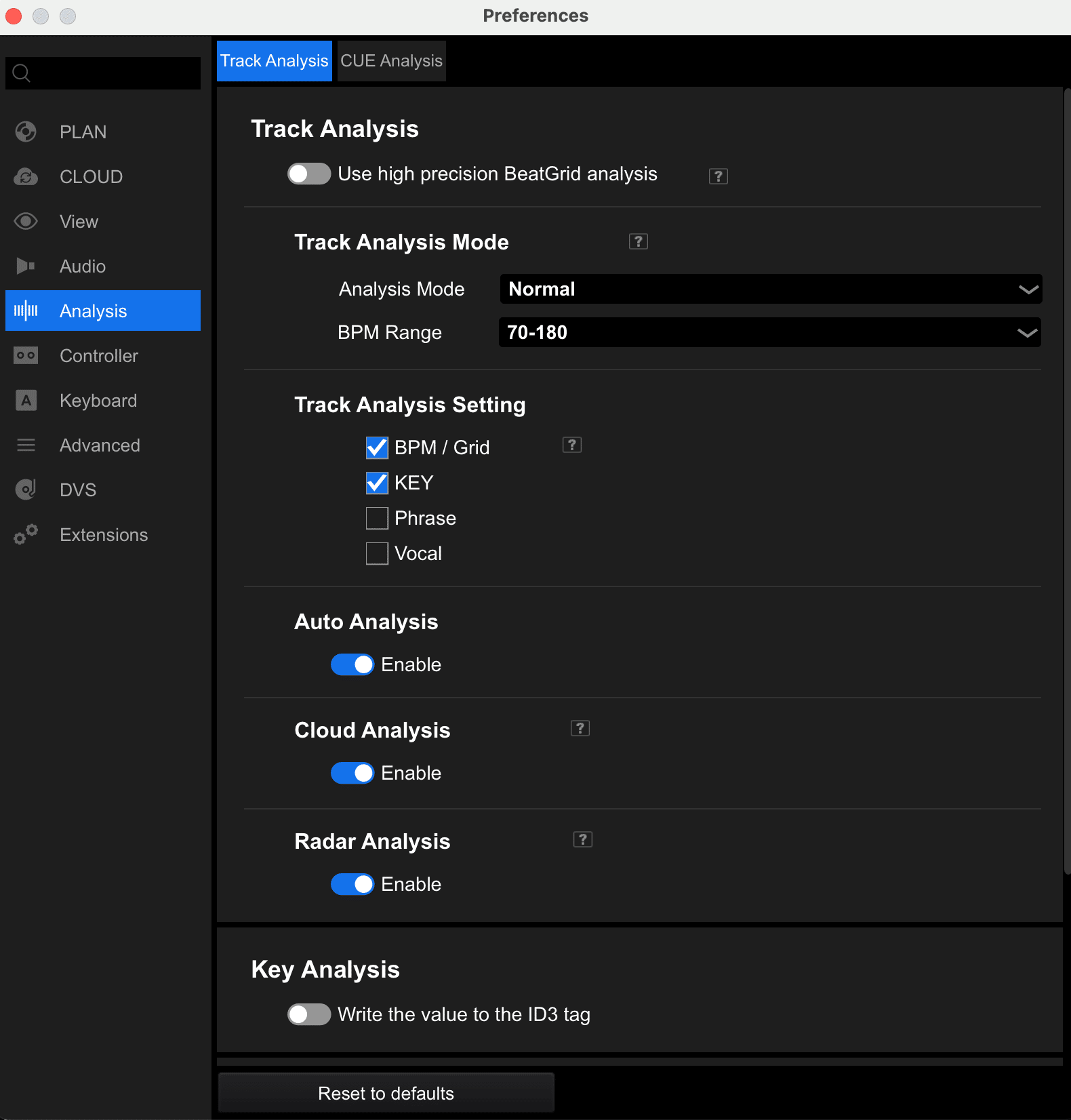
By accurately analyzing our music, Rekordbox can automatically determine the tempo of effects or other audio that needs to be synced with our tracks.
The rest of the settings should be checked as follows:
Importing & Finding Missing Files
There are several ways to import music into Rekordbox, such as dragging and dropping, using the explore feature, or importing playlists created in iTunes.
However, if audio files are missing or links become broken, it can cause problems in Rekordbox, such as silence or an orange exclamation mark next to the track.

This can happen if you move or delete files on your computer, so it is important to be careful when organizing and storing your music. To fix this issue, Rekordbox has a feature called “Relocate Missing Files,” which searches for moved files and re-links them.
To use this feature, you need to specify which folders or directories to search for missing files in the “Auto Relocate Search Folders” section under the “Advanced” tab in the gear icon menu. You can include external drives and add or remove specific locations from future searches.
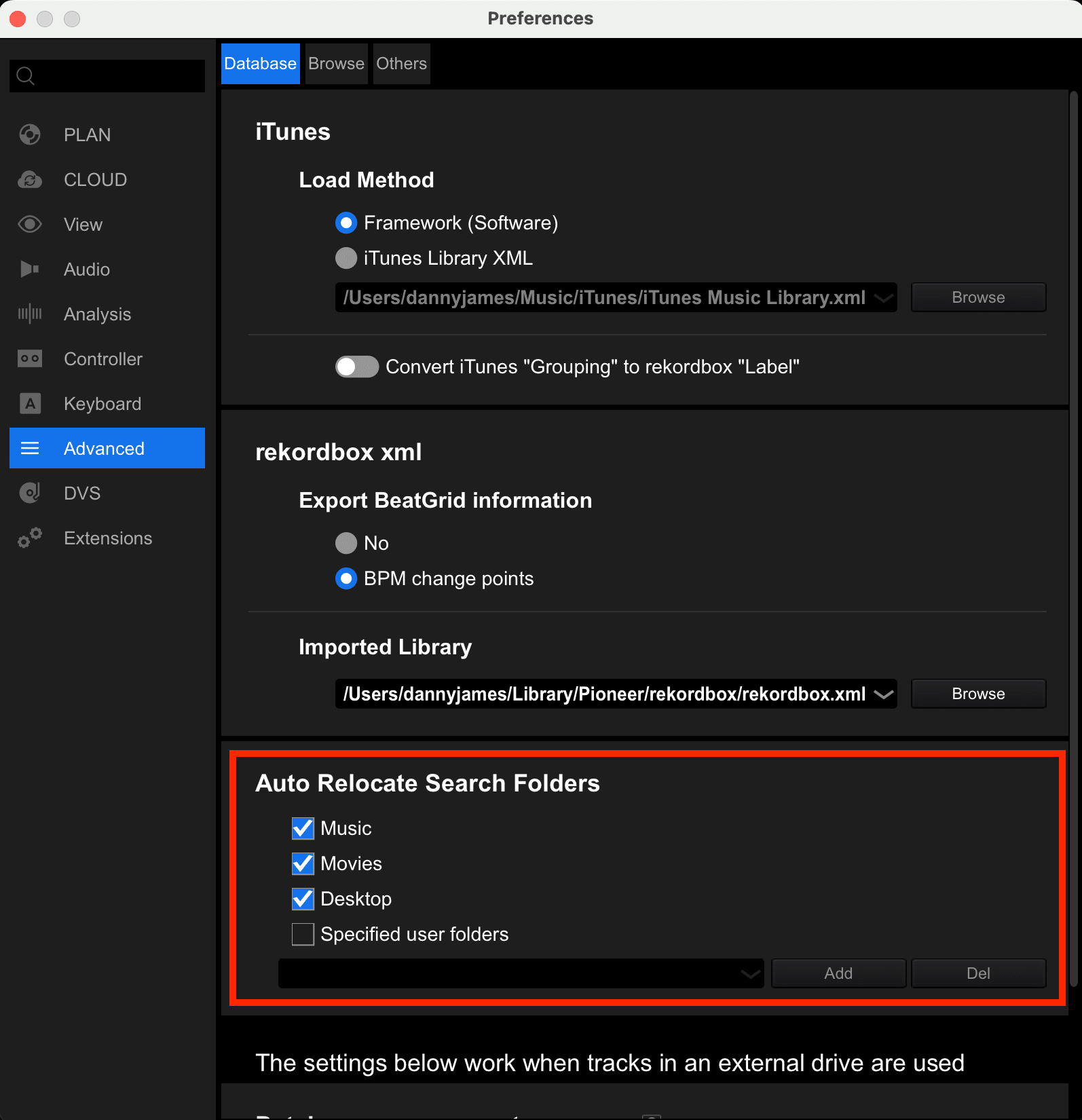
To relocate a single missing file, right-click it and select “Auto Relocate.” If you have multiple missing files, you can use the “Missing File Manager” by selecting “File” from the main navigation bar and then “Display All Missing Files.” Select the desired missing files and press the “Auto Relocate” button to fix them all at once.
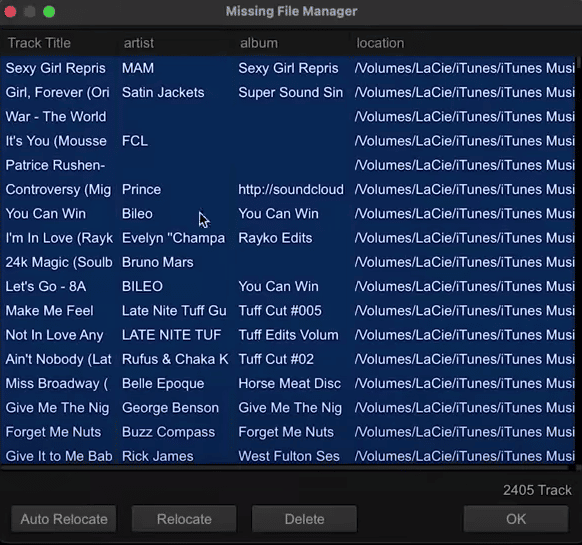
The process is very quick with Rekordbox being able to relocate hundreds of missing files within seconds on most modern computers!
Creating Rekordbox Playlists & Analysis
Once you have downloaded our free music pack, you will find 2 music sub-folders inside labelled 2019 and 2021, each containing several further sub-folders of music.
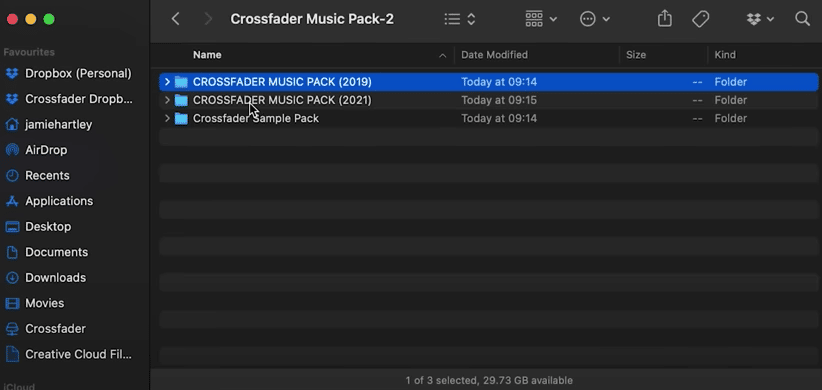
To import a music pack into Rekordbox, right-click in the playlist view on the screen and select “Create New Folder.” Then, drag and drop the music pack into the folder. This will automatically create playlists from the folders within the music pack.
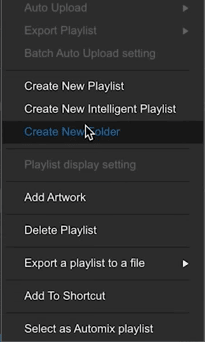
After the music pack has been imported, it will be analyzed and have performance data, such as BPM, key, and waveform overview, added to it. This performance data can be used to index your music in the playlist view and is displayed when a track is loaded into a deck.
You can customize the playlist view to show more or less information by right-clicking on a column header, such as BPM, and selecting the column headers you want to add or remove.
The column headers can also be rearranged to suit your preferences. If the sorting view is set to track number (#), you can rearrange the tracks in a playlist. However, if the sorting view is set to BPM, the tracks will be automatically sorted in ascending or descending order by BPM.
Viewing The Rekordbox Mixer
To mix tracks on a laptop using Rekordbox, configure the options in the navigation bar at the top of the screen. Set the Deck view list, located next to the Performance view drop-down list, to 2Deck Horizontal. This displays the waveform of each track horizontally, allowing you to see more of the track at a glance and get a better sense of upcoming parts.

Additionally, the mixer icon in the navigation bar should be selected (it will turn blue) to make the Rekordbox mixer visible between the two decks. The mixer is used to blend the music of the two decks together and create a cohesive mix.

Rekordbox Mixer & Layout
The mixer in DJ software or hardware consists of two upfaders, which are used to increase or decrease the volume of each track in a controlled way, and a crossfader below them.
On hardware DJ mixers, the crossfader is often used for quick audio stabs, such as scratching, but it can also be used to gradually blend audio from one deck to the other with one movement. This is the preferred method for using the crossfader with a laptop.
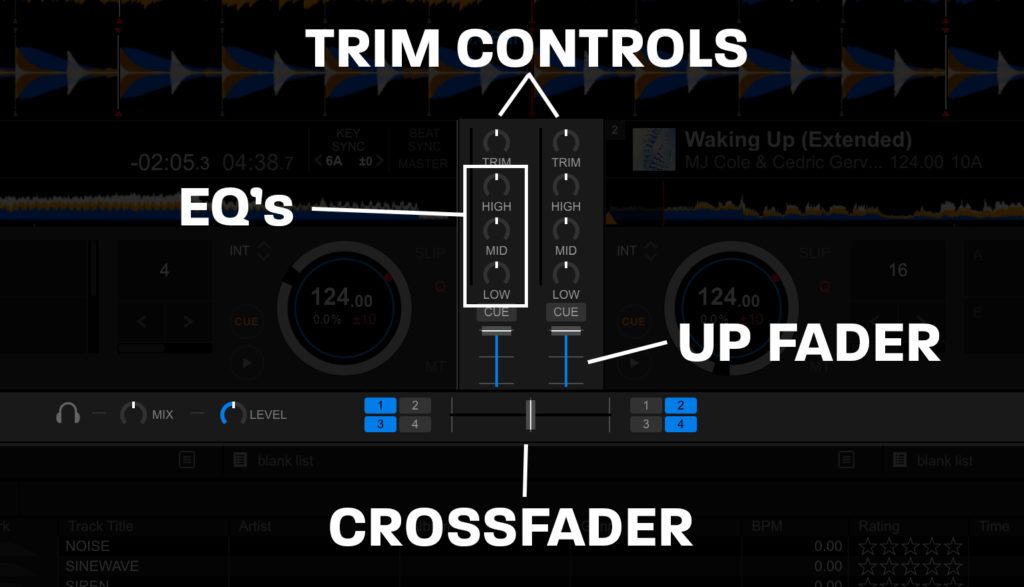
Above the upfaders are CUE buttons, which are used to send the audio of a specific deck to the headphones, and above those are EQ and Trim pots, which can be used to shape the sound of each deck and help with blending. This Rekordbox mixer includes the essential controls found on a basic two-channel club mixer.
The mixer is the main tool for mixing tracks, and it is particularly useful when no external equipment is connected. There are other functions, such as the sampler and effects, that can enhance your mixes, but it is best to start with the basics and learn to mix tracks before exploring these additional options.
Deck & BPM Controls
The decks in DJ software or hardware are the two music players that have controls that DJs use to mix audio. Each deck has a disc, which is like a jog wheel or turntable, with a BPM readout in the middle. To the left of each disc are two important buttons that DJs use when playing on controllers, XDJs, and CDJs: the PLAY button and the CUE button.
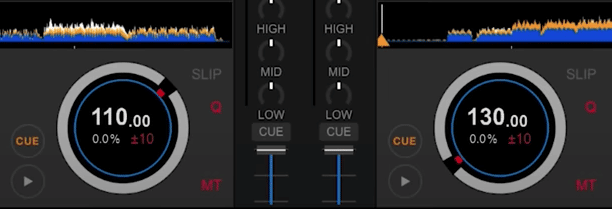
The PLAY button starts playback of the track, while the CUE button stops playback and snaps the track back to its original cue position. The default cue position of a track is the start of the song. It is good practice for DJs to hold down the CUE button to prepare tracks for mixing and preview the song. However, it is also possible to use the PLAY button to launch a track ready for mixing, but then use the CUE button to snap it back to the start position if you choose to mix from a different point.
Adjusting the Tempo of a Song
Beatmatching is the process of aligning the beats of two tracks so that they can be mixed together smoothly. Adjusting the tempo, or BPM, of a track is crucial for successful beatmatching.
On most DJ equipment, this is done using a slider on the right side of the jog wheel or platter. In Rekordbox, the tempo can be adjusted using the + and – buttons above and below the BPM readout.
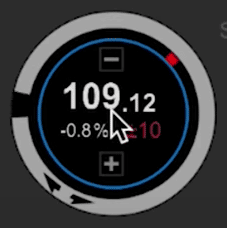
To beatmatch two tracks, make sure that their BPMs are the same by clicking the + or – buttons until the readouts match. If a track’s BPM has been adjusted and needs to be reset, double-click the BPM readout to return it to its original speed.
The MT feature, indicated by a red light at the bottom right of the deck display, stands for Master Tempo. When enabled, this feature allows a track to be sped up or slowed down without changing its pitch, allowing it to remain in the same key even as the tempo changes.
What is Beatmatching?
Nudging is a DJ technique that helps to realign the drums of two tracks if they are not perfectly in sync. This is often done by manually flicking the jog wheel with a wrist movement.
Nudging is useful for correcting small discrepancies in the timing or BPM of tracks, and can be used to get out of tricky situations where the tracks were not perfectly matched before the mix began. To nudge a track in Rekordbox, look for the two arrows at the bottom left of the deck display. The arrow pointing left temporarily speeds up the track, while the arrow pointing right slows it down. This emulates the nudging motion performed on CDJs by flicking the rim of the jog wheel in the same direction.
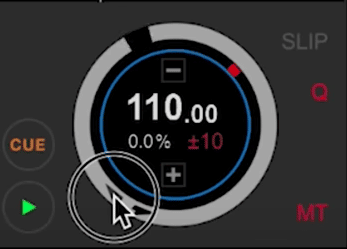
Knowing how to nudge can be helpful for any DJ looking to improve their beatmatching skills.
Can I Use Beat Sync?
The BEAT SYNC feature in Rekordbox makes it easier to mix tracks by automatically matching their BPMs. To use this feature, simply click it on above each deck. The master deck sets the tempo that both tracks will play at and is indicated by the orange MASTER icon. The MASTER deck can be automatically selected by Rekordbox when BEAT SYNC is enabled, or it can be manually set by clicking the MASTER button on the corresponding deck. However, for BEAT SYNC to work properly, the beat gridding of your tracks needs to be accurate.

BEAT SYNC and MASTER buttons in Rekordbox and on a CDJ
Rekordbox is usually able to accurately analyze and set the beat grid for most tracks, but some may require manual editing. This feature is especially useful for DJs mixing on a laptop, as it eliminates the need to manually adjust BPMs and nudge tracks.
Beats, Bars & Phrases
In order to effectively mix tracks as a DJ, it is important to understand the structure of the music you are working with. Most contemporary dance music follows a consistent structure, divided into beats, bars, and phrases.
The time signature of the music, usually 4/4, determines how it is divided into these units.
Beats are the individual thuds within a track, bars are made up of 4 beats, and phrases are typically 16 bars long.
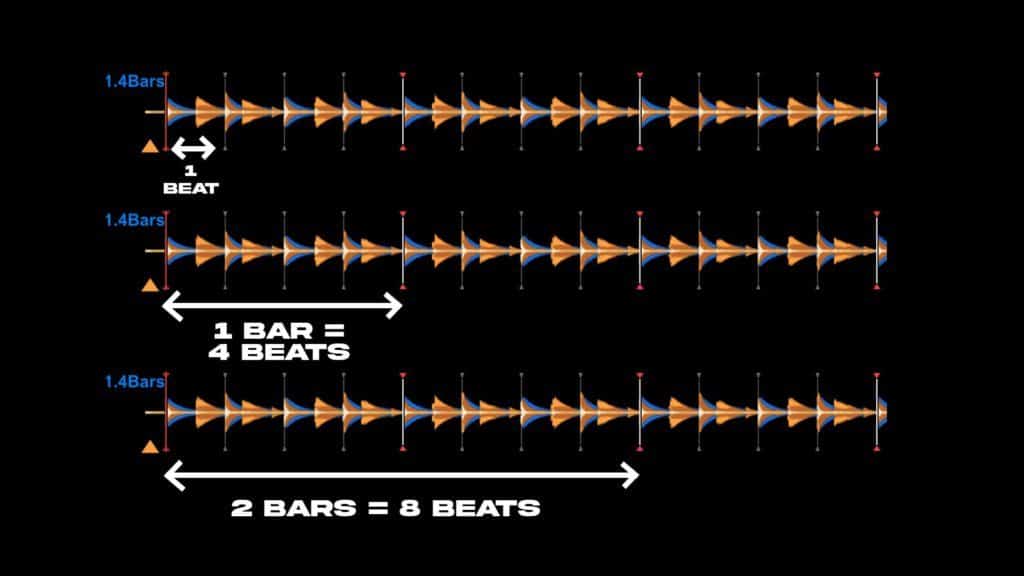
Bars of music explained. E.g. 4 Beats = 1 Bar
To create seamless transitions between tracks, it is best to start a mix on and at the top of a phrase, as this allows the elements of the incoming track to complement the outgoing track, resulting in a polished, professional sound. Understanding this music theory will help you speed up your learning and make mixing tracks feel like piecing together blocks of lego.
Mixing in Phrase
To mix in a phrase as a DJ, start by selecting a track that you want to mix in and cueing it up on a deck. Then, listen to the track that is currently playing and identify a good point to start the new track, such as using the last drop or the outro section to press play. When the time is right, use the crossfader to smoothly blend the two tracks together, adjusting the volume levels as needed.
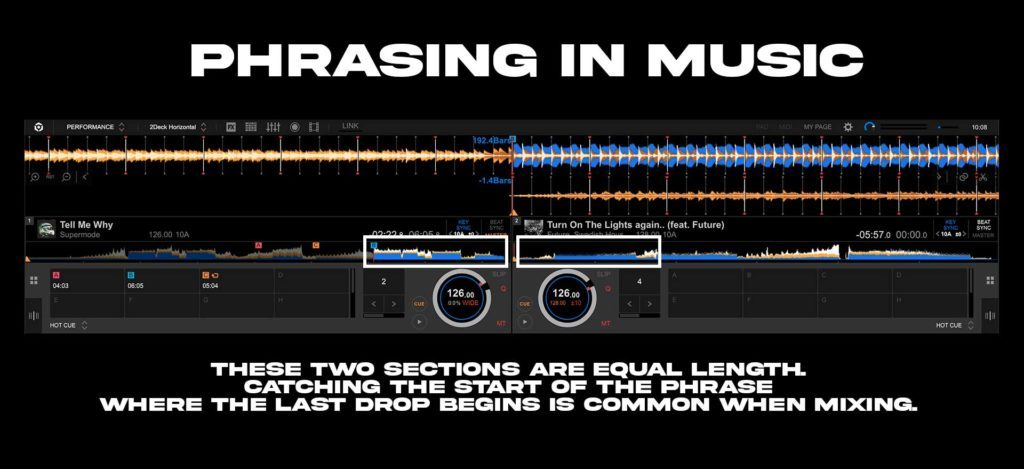
The last drop is always an excellent point to press play on your incoming track.
It can also be helpful to use EQ and effects to help blend the tracks together more seamlessly. As you mix the tracks, pay attention to the beatmatch and make any necessary adjustments to keep the tracks in sync. With practice, you will become more proficient at smoothly transitioning between tracks and creating a cohesive mix.
Your First Mix
To follow along please see the video tutorial at the top of this page.
To transition smoothly between the tracks “Lawrence James – Good Time” and “Zesto – The Way You Move,” it is important to ensure that the BPM of both tracks is the same. We can then begin by pulling down the fader on “The Way You Move” so it starts from silence. We should wait for an ideal phrase change on “Good Time,” such as after a chorus or drop, and then press PLAY on “The Way You Move.”
During the first 8 bars of play, we can slowly bring up the fader on “The Way You Move,” and at the same time, slowly pull down the fader on “Good Time” over the next 8 bars, leading to the breakdown on “The Way You Move.” If the mix out from “Good Time” is not complete by this point, the transition may sound confusing.
Mixing With The Crossfader
First, ensure that the BPM of both tracks is the same, and position the crossfader all the way to the side of the deck playing “Good Time.” Then, when a good phrase change occurs on “Good Time,” press play on “The Way You Move.” Slowly move the crossfader to the middle over 8 bars, and then, for the next 8 bars, move it all the way to the other side.
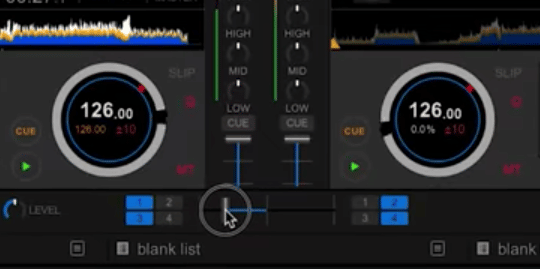
The crossfader will automatically increase the volume on one deck while simultaneously decreasing the volume on the other, eliminating the need for upfaders. We recommend establishing habits of using upfaders for mixing purposes, even though using a crossfader can be convenient for blending tracks on a laptop.
That’s it! Congratulations on your first DJ mix!
Next Lesson & Music Pack
Rekordbox is a comprehensive and effective DJ software, and the free mode used in this tutorial gives you access to many of its features. It is important to master making smooth transitions between tracks, and practicing will help you improve. In addition to using upfaders and the crossfader, you can also use EQ pots to adjust the sound of a track and make it easier to mix at any point.
In our second tutorial, we will show you how to use EQ settings and incorporate effects into your mixes. Sign up to access this tutorial and receive a free music pack. After mastering the basics of DJing on a laptop, you may want to consider purchasing DJ hardware, such as a Rekordbox controller. The DDJ-FLX4 is a versatile option that includes helpful learning aids and is compatible with Serato DJ.
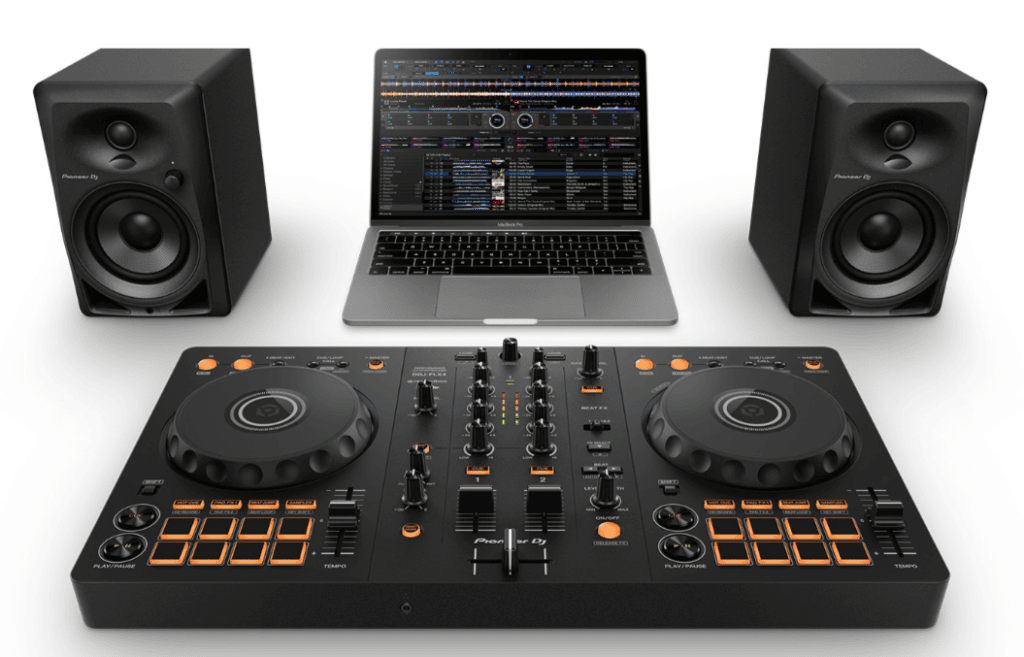
If you have found this tutorial helpful, there is more to learn in our beginner courses. These courses cover not only Rekordbox but also other popular DJ platforms and hardware devices from leading brands such as Pioneer and Denon DJ.
Want to become a professional DJ and fast? Jump on our Complete DJ Package for guaranteed success!
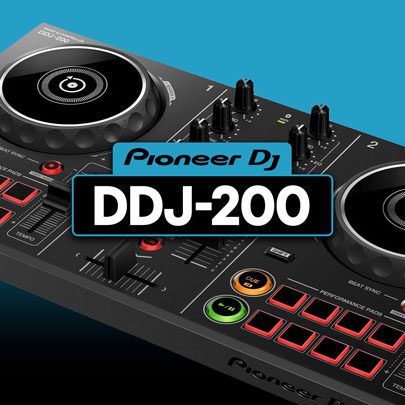
Pioneer DJ-200 DJ Course
4.75 hours
28 lessons
Beginner
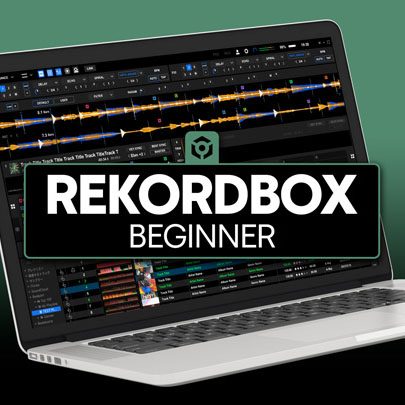
Rekordbox DJ Course
5.5 hours
37 lessons
Beginner
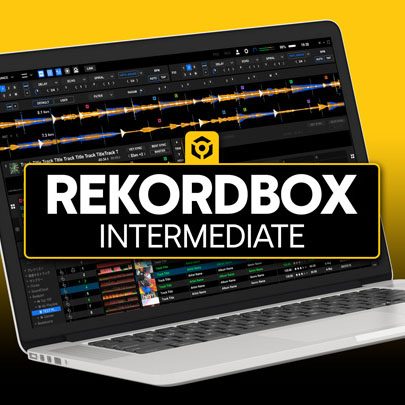
Rekordbox DJ Course
7.5 hours
49 lessons
Intermediate
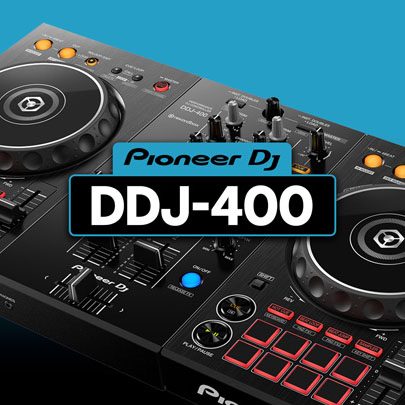
Pioneer DDJ-400 DJ Course
7 hours
30 lessons
Beginner
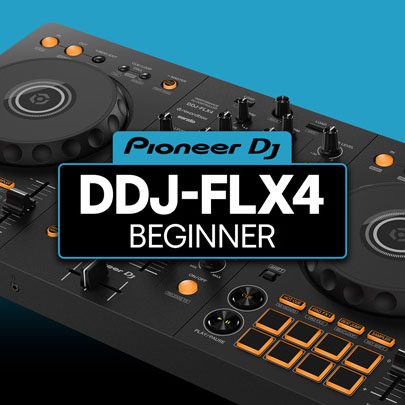
Pioneer DJ DDJ-FLX4 Course
7 hours
41 lessons
Beginner
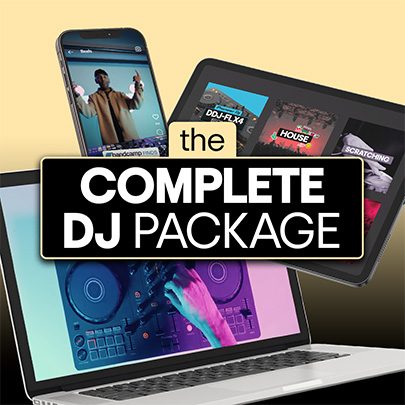
Complete DJ Package
835 hours
1300+ lessons
Creative
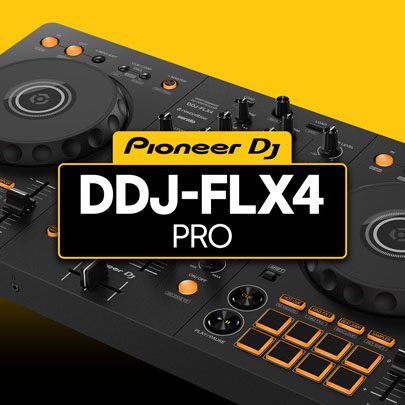
Pioneer DJ DDJ-FLX4 Pro Course
9.5 hours
49 lessons
Intermediate
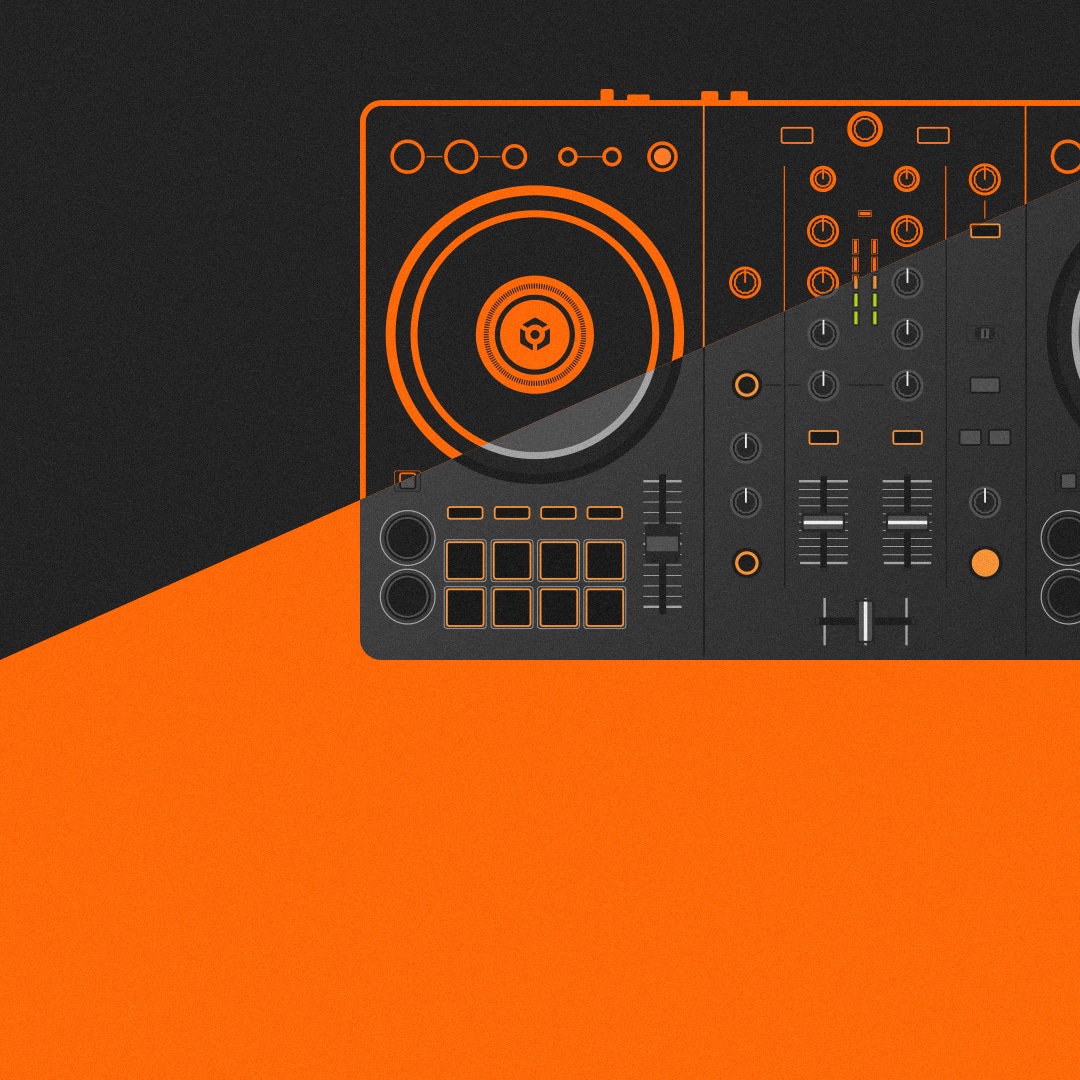
DDJ FLX4 Beginner To Pro Bundle
16.5 hours
90 lessons
Beginner

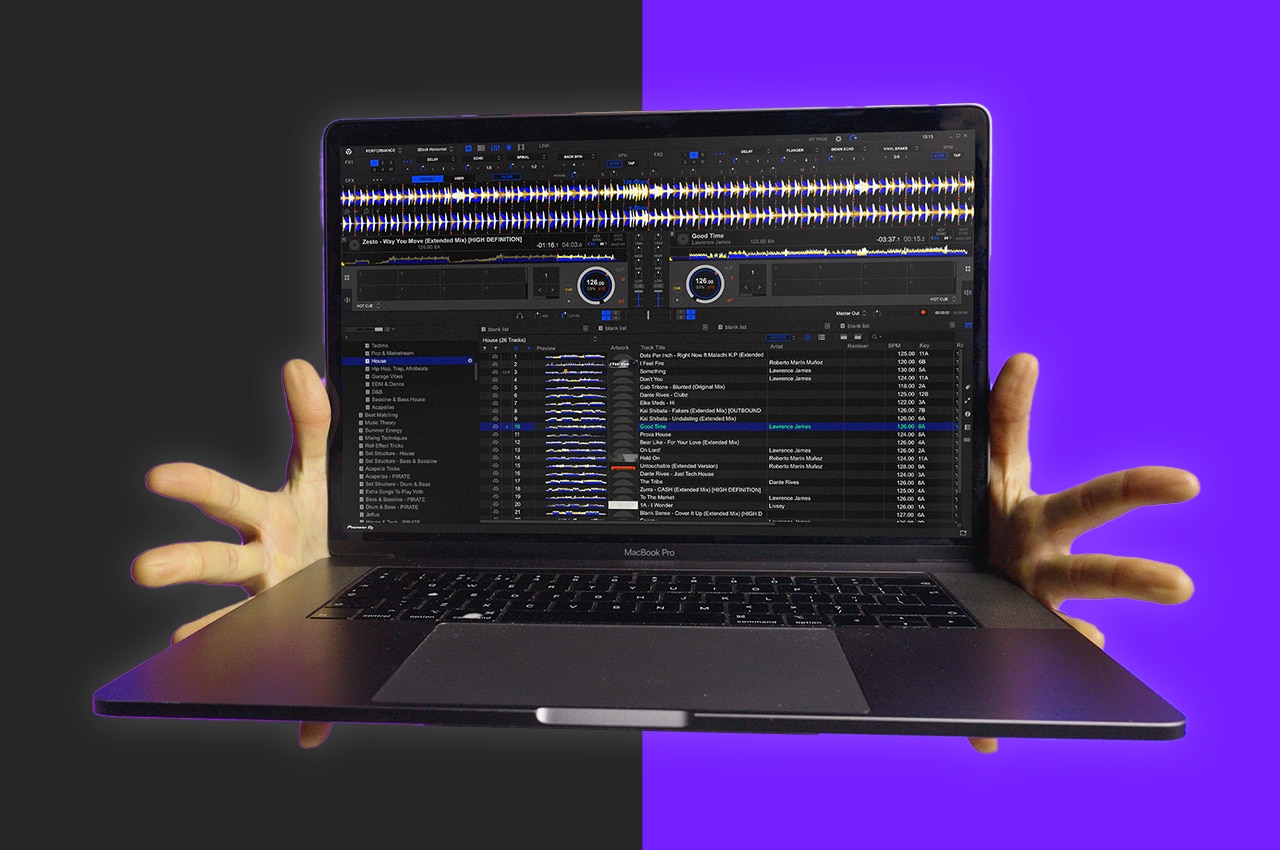

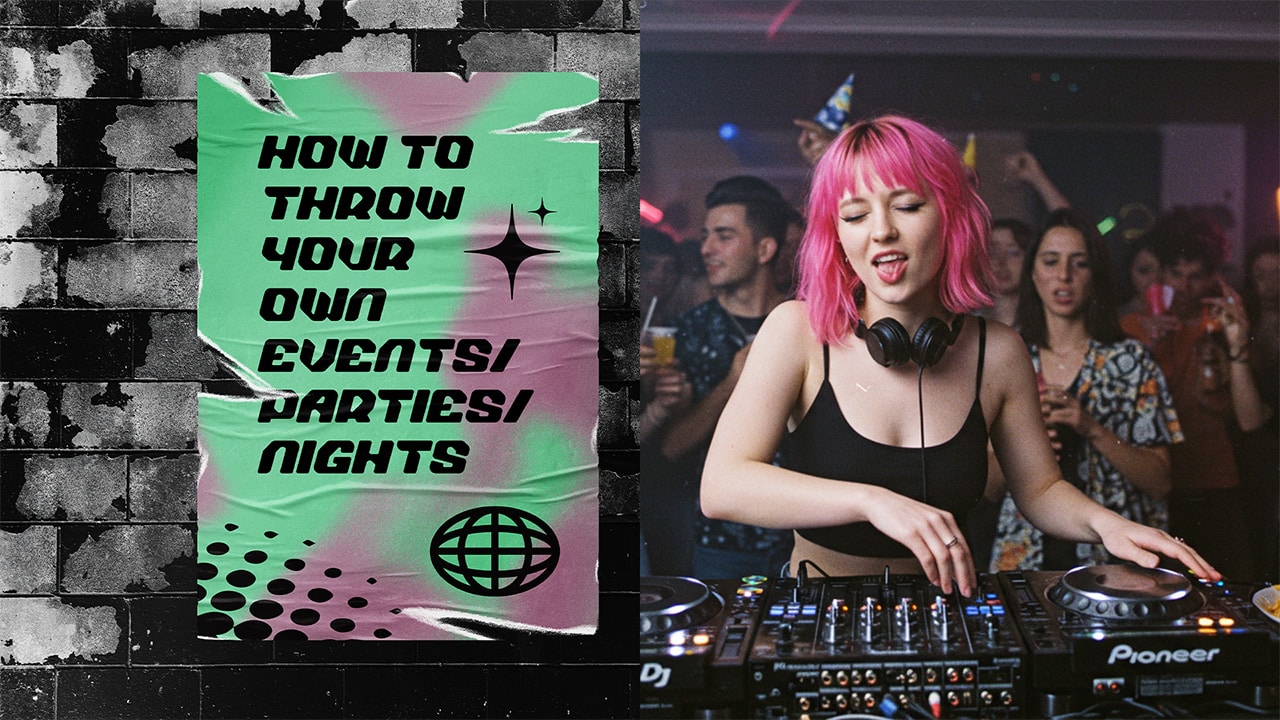
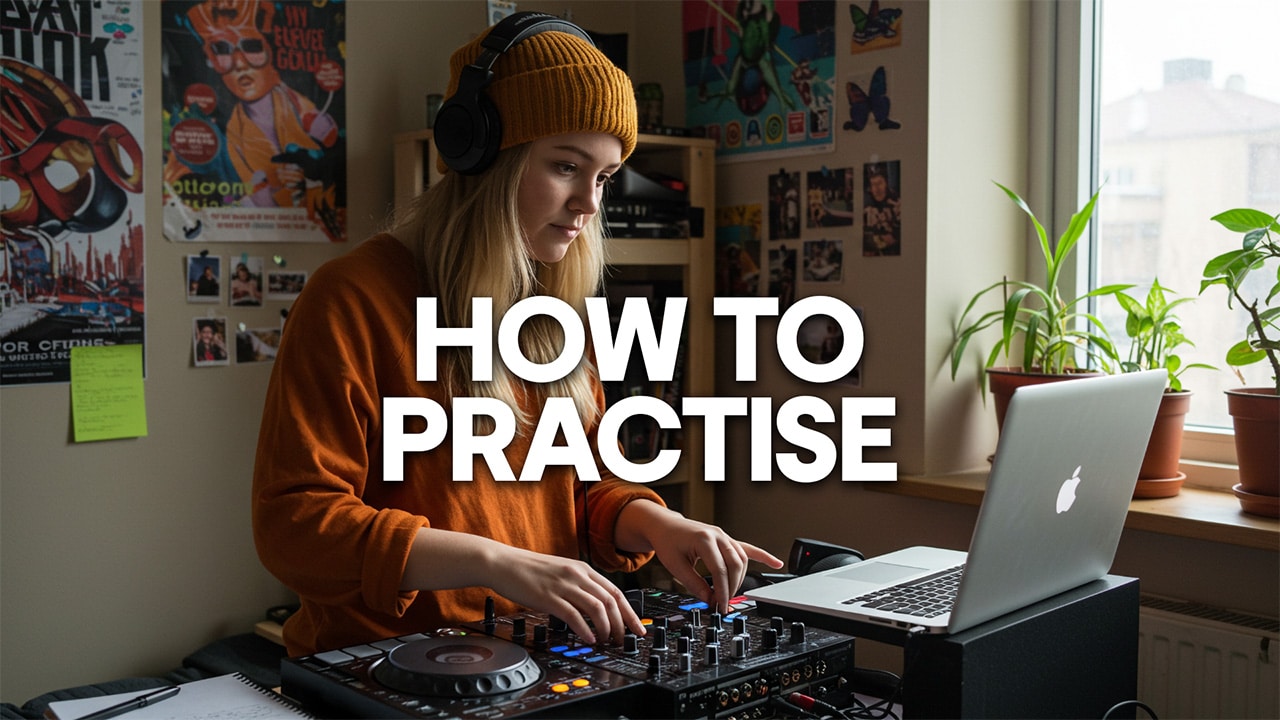
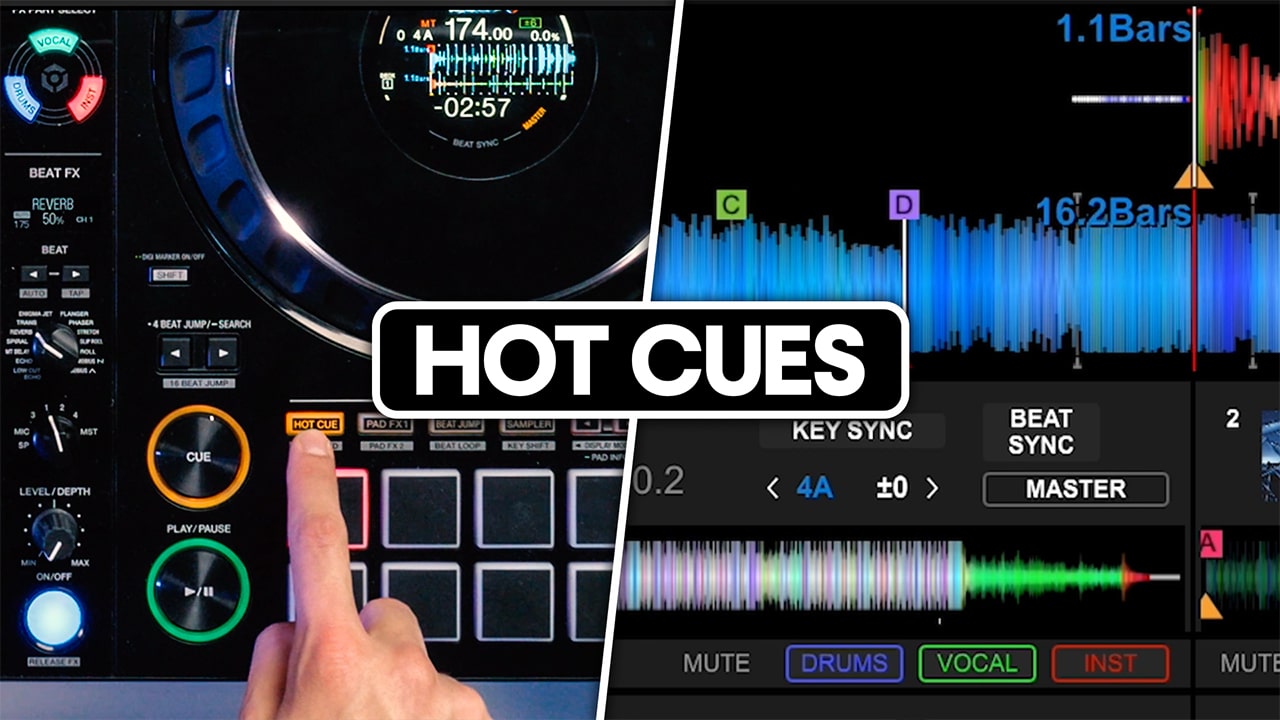
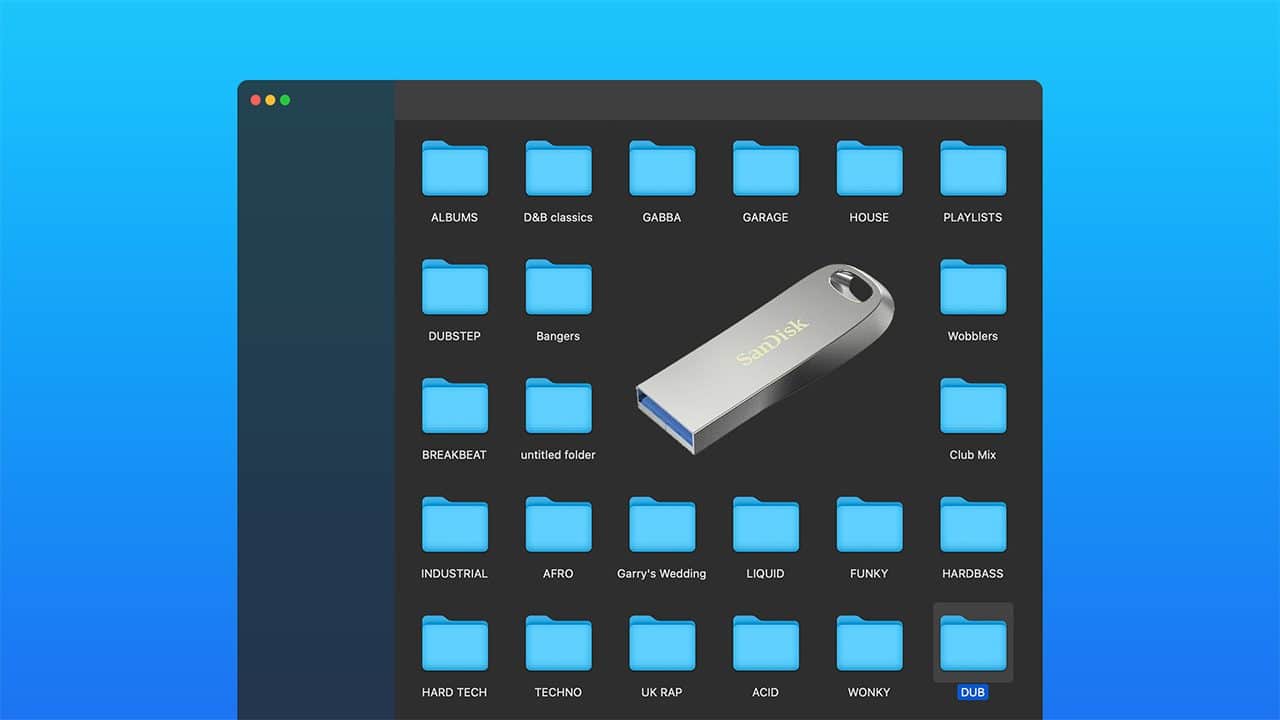
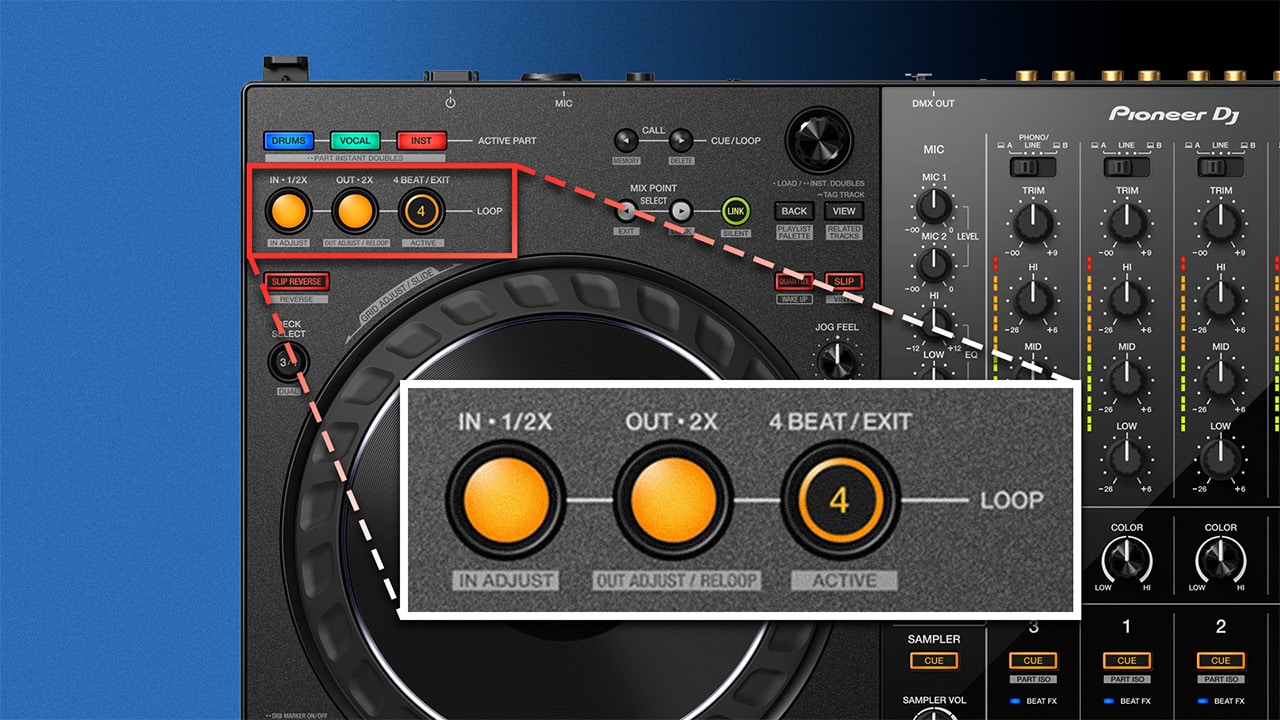
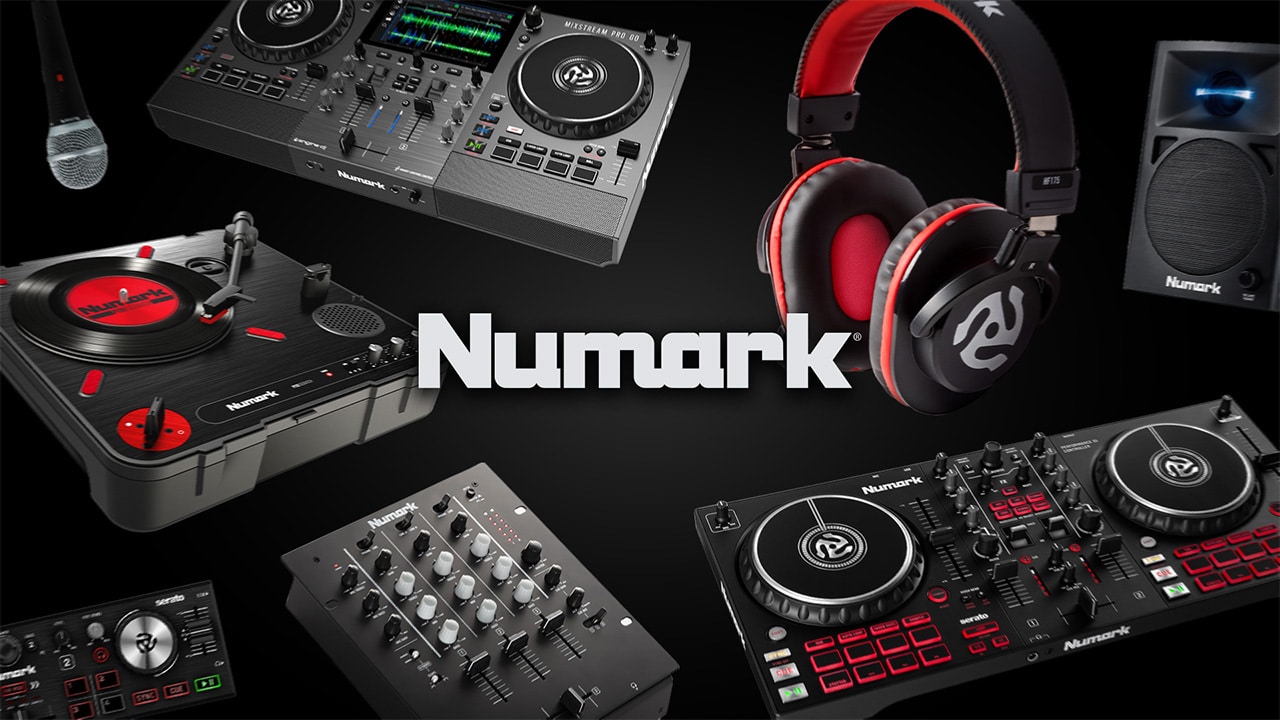
I would like to start practising dj. But I don’t have any idea about how to start, with which program, even dj set. I’m a litle bit lost in those things but I know I’m more from practise than from theory. So, if you could help how can I start or what different ways I can take, I would apreciate it a lot
Hi, you can get started trying out DJing without any gear with our free series of lessons on DJing with a laptop. Check out this video for more advice and download our free music pack.